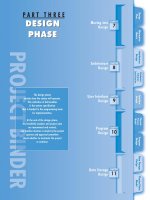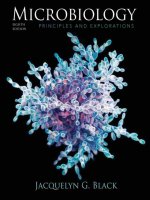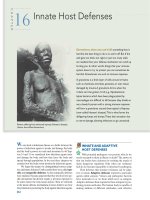Ebook Surgical tips and skills (1st edition): Part 1
Bạn đang xem bản rút gọn của tài liệu. Xem và tải ngay bản đầy đủ của tài liệu tại đây (3.81 MB, 147 trang )
‘The reward of a thing well done is to have done it.’
RALPH WALDO EMERSON
‘Today's heresy is tomorrow's orthodoxy.’
HELEN KELLER
This image shows the 20 triangulate faces of this polyhedron which are a reflection of
the versatility of this design concept, more variations of which are illustrated in this text,
which is really a second volume of the KPIF principle.
surgical
tips
and
Felix C Behan FRCS, FRACS
Associate Professor of Surgery
University of Melbourne
Plastic and Reconstructive Surgeon
Department of Surgical Oncology
Peter MacCallum Cancer Centre
Melbourne, & Western Health
skills
Sydney Edinburgh London New York Philadelphia St Louis Toronto
Churchill Livingstone
is an imprint of Elsevier
Elsevier Australia. ACN 001 002 357
(a division of Reed International Books Australia Pty Ltd)
Tower 1, 475 Victoria Avenue, Chatswood, NSW 2067
This edition © 2014 Elsevier Australia
This publication is copyright. Except as expressly provided in the Copyright Act 1968 and the Copyright
Amendment (Digital Agenda) Act 2000, no part of this publication may be reproduced, stored in any retrieval
system or transmitted by any means (including electronic, mechanical, microcopying, photocopying, recording or
otherwise) without prior written permission from the publisher.
Every attempt has been made to trace and acknowledge copyright, but in some cases this may not have been
possible. The publisher apologises for any accidental infringement and would welcome any information to
redress the situation.
This publication has been carefully reviewed and checked to ensure that the content is as accurate and current
as possible at time of publication. We would recommend, however, that the reader verify any procedures,
treatments, drug dosages or legal content described in this book. Neither the author, the contributors, nor the
publisher assume any liability for injury and/or damage to persons or property arising from any error in or
omission from this publication.
National Library of Australia Cataloguing-in-Publication entry
___________________________________________________________________
Author: Behan, Felix C., author.
Title: Surgical tips and skills / Felix Behan.
ISBN: 9780729540995 (paperback)
Notes: Includes index.
Subjects: Surgery–Textbooks.
Surgery–Technique.
Dewey Number: 617.9
___________________________________________________________________
Content Strategist: Larissa Norrie
Senior Content Development Specialist: Neli Bryant
Project Managers: Karthikeyan Murthy and Rochelle Deighton
Edited by Linda Littlemore
Proofread by Tim Learner
Cover and internal design by Stan Lamond
Index by Robert Swanson
Typeset by Toppan Best-set Premedia Limited
Printed in China by China Translation & Printing Services Limited
Foreword
The skills of a plastic surgeon are acquired
in many ways. Most surgeons learn their
craft from an experienced surgeon and then
modify their practice in the light of their
own experiences. It is not surprising that
changes in operative technique usually
occur slowly, only changing rapidly when
a new technology is introduced. This has
been most obvious in plastic surgery in the
emergence of microsurgery, which has
provided a method for the reconstruction of
many major defects. Unfortunately, simpler,
more traditional classical methods of tissue
transfer involving less operating time and
hospitalisation are sometimes forgotten.
Almost 100 years ago, a Melbourne plastic
surgeon, Jerry Moore, wrote a seminal book
entitled Plastic Surgery based purely on his
own personal experience and innovation. It
is pleasing to be asked to write a foreword
to an equally important book, Surgical Tips
and Skills by Felix Behan, which may also
change the face of plastic surgery. Like
Moore, Professor Behan is an original
thinker, and some 40 years ago he realised
it is possible to raise composite flaps using
embryological dermatomes, as these include
skin, neurovascular tissue, lymphatics and
fascia. He gradually developed his own
ideas of local tissue rearrangement based
on this principle, enabling him to close
defects that were previously irreparable. My
late brother Robert Marshall, surgeon and
anatomist, grasped this principle of the
vertical orientation of the circulation of the
skin and underlying tissue, and was
sufficiently impressed to include it in his
book, Living Anatomy, Structure as a Mirror
of Function, in 2001. Mr Marshall observed
to the author that the improved vascularity
in these island flaps may be a local
sympathectomy effect.
Professor Behan has continued his
innovative approach for more than 40
years, and shares with us in his new book
numerous examples of remarkable
reconstructions using local fascio-cutaneous
keystone flaps together with many relatively
simple but neat surgical tips to improve
surgical outcomes. This book is divided into
three sections, Basic, Intermediate and
Advanced, and there is something in it for
aspiring surgeons as well as for the most
experienced. The Basic and Intermediate
sections contain many surgical tips,
including suturing techniques, harvesting
of skin grafts and their applications, simple
means of immobilisation and innovative
methods of establishing drainage to
improve the results of many plastic
surgery procedures. The Advanced section
has beautifully illustrated examples of
keystone fascio-cutaneous flap
reconstructions, which many experienced
surgeons would be pleased to claim as
their own.
Plastic surgery has changed over the past
50 years, becoming dominated by cosmetic
surgery and microsurgery with a decline
in the art of local tissue repair, which is the
fundamental basis of plastic surgery. It is
to be hoped this book may stimulate a
resurgence of the more classical aspects of
the specialty. With the passage of time and
tightening of resources, there will inevitably
be more scrutiny by health administrators of
the cost of plastic surgery procedures. It will
become increasingly difficult to justify
operations that require expensive resources,
multiple surgeons and prolonged operating
times, when there are simple, less expensive
alternatives readily available that produce
results often superior in terms of function
and appearance. Professor Behan has
shown the way – plastic surgeons need to
sit up, take notice and embrace local
fascio-cutaneous island reconstruction as
an alternative to microsurgery or risk losing
a large part of our specialty.
Donald R. Marshall
AM MB MS FRACS FACS
v
Foreword
vi
All surgeons enjoy discussing and
evaluating surgical techniques. Innovative
means of practising their craft are a
constant stimulus. They also value the
visual and even graphical demonstration
of surgical procedures, as comprehensively
illustrated in this text.
This surgical interest ranges from the
simple to the complex. A simple procedure
done well that produces a functional
outcome is as important as a major
reconstruction after resection of a cancer.
Felix Behan has vast experience in
both simple and complex reconstructive
techniques, honed by many years of
practice at the Peter MacCallum Cancer
Institute and the Western Hospital in
Footscray, Melbourne. His work has
encompassed both community trauma,
including orthopaedics, and melanoma
and other malignancies.
He worked as a senior plastic and
reconstructive surgeon at both these places
for almost 40 years, but his contribution has
been much more than the conventional.
His techniques were noted to be original,
and were carried out expeditiously with
wonderful outcomes, as comprehensively
illustrated throughout the text in the
Basic, Intermediate and Advanced sections.
His work was initially regarded as
idiosyncratic and was attributed to his
innate skill in dealing with and repairing
tissue with the keystone techniques.
However, it is an accepted truism that a
surgical technique that cannot be taught
will have minimal impact on surgical
science without publication in the
international literature.
I take some pride in having encouraged
Felix to document his work scientifically, to
classify it in a way that allows independent
evaluation and, thus, to publish it for wider
scrutiny of the keystone reconstructive
principle.
The rest, as they say, is history, and
now surgeons all over the world have
learnt the simple but precise principles
of reconstruction as developed by Felix
Behan. The photographic details in
each section of this book will make the
learning process even simpler.
His work has been published in the
surgical literature and in previous textbooks,
and he has presented his work around the
world at multiple clinical meetings.
I am pleased to write the Foreword to
this new volume, entitled Surgical Tips and
Skills, which adds extra detail to these
surgical techniques that have now been
accepted internationally. Understanding
the principles behind the effective
reconstruction of a skin defect is critical
for a good outcome. This textbook is filled
with handy hints and clever surgical
techniques to enable both the surgical
tyro and the experienced surgeon to
develop and amplify their reconstructive
skills.
Few surgeons can claim a real advance
in surgical technique. This volume indicates
that here is one surgeon who has made a
real contribution. Through his photographs,
drawings and notes, this conclusion is made
clear. I commend Felix Behan for his
innovative work. The many patients who
have benefited from his innate skill and
techniques will be forever grateful for his
ability, intelligence and endeavours, as
will those in the future as other surgeons
embrace these principles. Surgical Tips
and Skills is really a summary of his work
as a reconstructive surgeon in this second
volume focusing on the keystone perforator
island flap concept.
Robert J S Thomas
Distinguished Fellow in Surgical Oncology
Peter MacCallum Cancer Centre
Melbourne
Preface
Surgical Tips and Skills is a compilation
covering aspects of surgical development
with ongoing refinements in surgical
technique based on experience. The fact
that one keeps seeking higher standards of
surgical outcome leads one to question
one’s own ability. Eventually, the
accumulation of this experience bears fruit.
One has only to compare the techniques
and achievements of one’s earlier years to
see the advantage of this maturation
process.
This text is essentially a summary of 40
years of experience practising surgery in
both the public and the private domains.
The advent of digital photography
supersedes reams of text, which are
sometimes hard to comprehend. The
alphabetical sequence, common to modern
surgical textbooks for ready reference,
is an attempt to cover the gamut of
reconstructive cases that present in any
surgical domain, based on one central
tenet: the simplest way is usually the best.
With the advantage of external reviewers,
the levels of expertise were factored in to
create three sections of the book covering
Basic, Intermediate and Advanced stages
of this technical development. The text also
includes a comprehensive index.
As a consequence, the principles of
evidence-based medicine – initiatives to
improve health management and health
outcomes while reducing health costs – are
reflected in all these cases, with Level 5
(expert evidence and opinions) and Level 4
(retrospective case series). All the singular
cases illustrated are just examples of the
many that have been compiled and have
either been presented internationally at
meetings or are in the process of separate
publication, or both.
This compilation, drawn from
approximately 3000 keystone flap
reconstructions over the past 20 years in all
regions of the body, has created a ‘How To
Do’ guide on some reconstructive facets
that others find difficult. It is interesting that
the Annals of the Royal College of Surgeons
of England is now in the 10th year of
‘Technical Tips’ – meaning people like to
read pearls of wisdom. The science of the
keystone has many elements, with recent
publications looking at the evidence – the
flaps are closed under tension and the
vascular dynamics characteristically
displayed contradict established principles of
plastic surgery, requiring further elucidation.
The anatomical construction of skin, fat
and fascia, a prerequisite to any successful
keystone flap, is indispensable and the
mark-outs within the dermatomes echo the
embryological development of the human.
Speaking in Paris recently, a senior plastic
surgeon, Dr Arnoldo Fournier, said to me:
‘Felix, you have captured the art of
reconstruction by these principles’. He was
referring to the fact that every keystone
aligned along the dermatomes has both
somatic and autonomic support to
supplement the arterial and venous
connections while not negating any
lymphatic and humeral input. Microsurgery
is based on an artery, a vein and possibly
a nerve and thus has a different structural
arrangement. Historically I must publicly
recognise the contribution of Professor
Gordon Clunie in relation to the publication
of scientific material as editor of the ANZ
Journal of Surgery. He told me that with any
new scientific principle “launch it locally,
and you will get full recognition”. His other
famous recommendation was “if you have
anything to say in print, find the time to
publish”. Professor Bob Thomas also gave
me sound advice in 2003, when the first
article on the keystone was submitted to the
ANZ Journal of Surgery with multiple
authors. He said, “This is a good idea. It’s
yours and have it as a single author.”
xi
This ‘technical tips’-style of publication is
a means of illustrating how to employ these
techniques. I hope this straightforward,
comprehensively illustrated presentation will
encourage many more of my colleagues,
at whatever stage of their careers, to
xii
re-explore loco-regional reconstruction
in conjunction with microsurgical
expertise.
This Surgical tips and skills is a
companion volume to the first publication:
Keystone perforator island flap concept.
Acknowledgments
Surgical Tips & Skills is really a companion
textbook to our first publication, The
Keystone Perforator Island Flap Concept.
Some have even called it ‘Volume II’ in view
of its extensive range of cases featuring this
KPIF principle.
I must acknowledge first and foremost
all the patients and the referrals from
my oncologist and surgical colleagues,
Professor Andrew Sizeland, Associate
Professor Steve Kleid and Dr Sorway Chan
at Peter MacCallum, together with Professor
Steve Chan and Associate Professor Trevor
Jones, and the members of the orthopaedic
team, including Associate Professor Ray
Crowe and Associate Professor Chris Harris
at the Western Hospital. The patients have
repeatedly said they are grateful for the
work we have all achieved, and without
reservation they gave me permission to
compile and use a photographic record of
these cases to detail these reconstructive
manoeuvres and ‘help anyone else like us’.
Next I must publicly acknowledge the
staff at both these institutions, from the
wards, from theatre and the clinics, at both
the surgical and the nursing levels. Without
their input, of course, the clinical success
could not have been assured.
I am grateful for the invaluable help
offered by the library staff at the Western
Hospital for researching almost every aspect
of every reference used in the text.
It was my French colleague, Dr T
Boukris, who originally suggested the term
‘omega variant’ for the horseshoe-shaped
design used throughout.
I am also grateful for the technical
expertise and assistance of the following:
•Kevin Tan, for his IT expertise, who
compiled the initial submission of the text,
constructing the alphabetical sequence of
cases.
•Ashwini Supperamohan as an Editorial
Assistant who in the intermediate phase
composed the initial quartet arrangement
of the clinical images from my extensive
photographic records to make the text
as clear as has been achieved in this
format.
•Andrew Sanderson, also as an Editorial
Assistant, who contributed to the
penultimate stages of preparation
including drawings.
•Margaret Clancy, who refined the final
text with me to produce the end result as
a readable, logical and easily accessible
format.
I am also indebted to all the confidential
reviewers for their constructive suggestions,
which resulted in the progression of cases
spread over three tiers of competency. This
may help explain the format.
Lastly I must acknowledge the tolerance
of my wife, Mariette, for my hours and days
of absence during this compilation period.
xiii
Reviewers
Peter F Burke MBBS (Melb) FRCS (Eng) FRACS FACEM DHMSA
Senior Consultant Surgeon, Latrobe Regional Hospital, Traralgon, VIC, Australia
Steven Chan MBBS PhD (Lond) FRACS
Professor of Surgery, The University of Melbourne, NorthWest Academic Centre, VIC,
Australia
Tim Francis BSc MBBS FRACGP
General Practitioner, Nambucca Heads, NSW, Australia
Sarah-Jane McEwan BMed DCH FRACGP FARGP AdvDRANCOG FACRRM CertClinEd
District Medical Officer, Hedland Health Campus, Port Hedland, WA, Australia
Julian Peters BMedSci (Hons) MBBS, FRACS (Plast)
Senior Consultant Plastic Surgeon, The Royal Melbourne Hospital, Parkville, VIC, Australia
xiv
Acronyms used throughout the text
– key words
AFX
atypical fibroxanthoma
BCC
basal cell carcinoma
BSS
balanced salt solution
CSM
cervicosubmental (KPIF)
DRAPE
delayed reconstruction after pathology evaluation
EDM
embryological dermatome mark-outs
FETS
figure-of-8 tension suture
FFTG
fenestrated full thickness graft
HEMMING
horizontal everting mattress method of suturing
HMF
Hutchinson’s melanotic freckle
IDPF
island delto-pectoral flap
KPIF
keystone perforator island flap
LLSS
Luer-lock suction system
LMS
locking mattress suture
MM
malignant melanoma
ODEL
ocular design with extended limbs
PH
paradoxical hyperaemia
QOL
quality of life
RDS
red dot sign
SCC
squamous cell carcinoma
SFPF
skin/fat/platysma/fascia – the basis of the CSM
SMAS
superficial muscular aponeurotic system (facial tissue)
SMLS
strategic mattress locking sutures
TMS
tension mattress sutures
TUT
teasing under tension
Ω
omega variant
xv
BASIC
1/2
Draping technique for hand surgery operating table
PREOPERATIVE
Introduction
The biggest problem with hand surgical
tables is the underlying sterile, waterproof
sheeting, which allows sliding of the
multilayered drape coverings.
Problem
The green drapes on a hand table are
unstable because of the plastic
waterproofing in the deep layer.
Solution
of the soft rubber mattress to create a drum
effect at the four corners, providing a
comfortable, stable operating surface.
The ‘cut-off’ green drape at the
advancing side of the table, above the
wheels, is driven into the side of the
operating table with the patient’s arm
elevated, and this is closed around the
region just above the cubital fossa. The
long drapes between the drip poles, from
the pillow to the foot, separate the
anaesthetic area from the operating area.
Staff at the vascular unit of the Western
Hospital place towel clips below the level
SURGICAL TIPS AND SKILLS
2
Figures 1, 2: The use of towel clips at each corner eliminates
sliding of the drapes and creates an even surface for
photography
Notes ________________________________________________________________________________________
_____________________________________________________________________________________________
_____________________________________________________________________________________________
_____________________________________________________________________________________________
BASIC
Draping technique for hand surgery operating table
2/2
Notes _____________________
___________________________
___________________________
___________________________
PREOPERATIVE
Figure 3: The cut-off drape
closed just above the cubital
fossa and the normal
instrument set-up
___________________________
___________________________
Outcome
A better operating field.
Bibliography
Green, D.P., 2005. Chapter 1: ‘General principles’. In: Green, D.P., Hotchkiss, R.N., Pederson, W.C.,
Wolfe, S.W. (Eds.), Green’s operative hand surgery, fifth ed. Elsevier Churchill Livingstone, Philadelphia,
pp. 3–24.
SURGICAL TIPS AND SKILLS
3
BASIC
1/2
Exsanguination problems in hand surgery
PREOPERATIVE
Introduction
As a preamble to hand surgery, a firm
but not excessively tight tourniquet is
applied, before exsanguination, over the
biceps region to prevent any venous dilatory
impedance.
Problem
Figure 1: Application of a tight
pneumatic band before
exsanguination produces
venous filling and presumably
stasis. This negates the
effectiveness of the RhysDavies exsanguinator. Excess
venous filling may prevent a
completely exsanguinated field
being achieved
Notes _____________________
___________________________
___________________________
___________________________
Figure 2: The presence of
excess venous filling because
the tourniquet in situ has been
applied too tightly before
exsanguination. The firm
tourniquet must slide up and
down the biceps
Notes _____________________
SURGICAL TIPS AND SKILLS
4
___________________________
___________________________
___________________________
___________________________
___________________________
___________________________
BASIC
Exsanguination problems in hand surgery
Start again. Release the tourniquet,
minimise any filling and reuse the
Rhys-Davies exsanguinator to produce
a bloodless field. If the tourniquet is too
loose before pressure application, leak
invariably occurs during the procedure.
There’s nothing like having to reapply the
tourniquet because of an oozing field in
a difficult Dupuytren’s dissection.
Figure 3: Release the
tourniquet at the Velcro®
fitting sufficiently so that it is
still firm but loose enough to
slide up and down the biceps
segment of the upper limb
Notes _____________________
PREOPERATIVE
Solution
2/2
___________________________
___________________________
___________________________
___________________________
___________________________
___________________________
Figure 4: Excess venous filling
minimised
Notes _____________________
___________________________
___________________________
___________________________
___________________________
___________________________
___________________________
___________________________
___________________________
Outcome
Failure to perform this manoeuvre often
results in tourniquet leak.
Bibliography
Green, D.P., 2005. Chapter 1: ‘General principles’. In: Green, D.P., Hotchkiss, R.N., Pederson, W.C.,
Wolfe, S.W. (Eds.), Green’s operative hand surgery, fifth ed. Elsevier Churchill Livingstone, Philadelphia,
pp. 3–24.
Oragui, E., Parsons, A., White, T., Longo, U., Khan, W., 2011. Tourniquet use in upper limb surgery. Hand
6, 165–173.
SURGICAL TIPS AND SKILLS
___________________________
5
BASIC
1/1
Wound preparation – pre-wash technique
PREOPERATIVE
Introduction
Every surgical wound, dirty or otherwise,
is prepared with a pre-wash using Savlon,
Betadine® or alcoholic solutions before
commencing the procedure.
This is applicable to any surgical site,
particularly the head and neck, hands and
feet.
Solution
Pre-wash technique is performed with the
tourniquet applied (so contamination and
blood are not present in the wound).
Macroscopic removal is best done to
eliminate any nidus of potential infection
harboured in the contaminants using soft
cotton towelling (not paper).
Problem
Minimising wound infections in surgical
sites.
Figure 1: The cleaned hand,
now ready to be sterilised
Notes _____________________
___________________________
___________________________
___________________________
___________________________
___________________________
___________________________
___________________________
___________________________
If you start with iodine, stick with iodine; if
you start with Savlon, stick with Savlon. Do
not interchange cleaning solutions as they
may cross-react and become ineffective.
SURGICAL TIPS AND SKILLS
6
Outcome
A lower rate of postoperative infective
wound infection complications.
BASIC
Unpleasant aromas in theatre
A general surgical referral with tissue
necrosis of the integument occur
periodically. The aroma in theatre can be
overwhelming to theatre staff, sometimes
numerous staff, even though any likelihood
of sensitivity to the aroma amongst the staff
has been excluded. Application of a
deodorant for the surgeon’s comfort does
not extend to the other theatre staff.
Problem
How to deal with the odour.
Figure 1: The ‘aromatic’
surgical problem of necrosis of
the abdominal wall
Notes _____________________
___________________________
PREOPERATIVE THEATRE PREPARATION
Introduction
1/3
___________________________
___________________________
___________________________
___________________________
___________________________
___________________________
SURGICAL TIPS AND SKILLS
7
BASIC
2/3
Unpleasant aromas in theatre
PREOPERATIVE THEATRE PREPARATION
Solution
Add 100 mL of eucalyptus oil to a bucket
of warm tap water (approximately 60°). This
oil becomes aromatic at 49°. However, to
increase diffusion throughout the operating
theatre suite, an oxygen source can be
directed from the anaesthetic machine into
the eucalyptus oil solution to increase
permeation and social relief.
Figure 2: The anaesthetic machine delivering 8 L of
oxygen per minute
Notes _________________________________________
_______________________________________________
_______________________________________________
_______________________________________________
_______________________________________________
_______________________________________________
_______________________________________________
_______________________________________________
_______________________________________________
_______________________________________________
_______________________________________________
_______________________________________________
_______________________________________________
Figure 3: Tubing connecting
the anaesthetic machine to
the eucalyptus solution bucket
increases the aeration and
deodorising effect
Notes _____________________
___________________________
___________________________
SURGICAL TIPS AND SKILLS
___________________________
___________________________
___________________________
___________________________
___________________________
___________________________
___________________________
___________________________
8
___________________________
BASIC
Unpleasant aromas in theatre
3/3
Notes _____________________
___________________________
___________________________
___________________________
___________________________
___________________________
___________________________
Figure 5: Resultant defect
awaiting VAC dressing and
reconstruction with skin
grafting
Notes _____________________
___________________________
PREOPERATIVE THEATRE PREPARATION
Figure 4: Completion of the
debridement of the abdominal
wall necrosis
___________________________
___________________________
___________________________
___________________________
___________________________
___________________________
___________________________
___________________________
___________________________
Outcome
Approximately 5 minutes to set up, resulting
in a tolerably acceptable theatre
environment.
SURGICAL TIPS AND SKILLS
___________________________
9
BASIC
1/3
Aesthetic closure – ocular design with extended
limbs (ODEL)
INTRAOPERATIVE
Introduction
Besides punch biopsies, the definitive biopsy
excision provides a solution to the problem
when there is clinical suspicion of a mitotic
lesion.
Solution
The ocular design with extended limbs
(ODEL) accommodates the tightness of the
redundant tissue at the extremes of the
‘ellipse’.
Problem
Closing the wound without dog ears.
Figure 1: BCC (L) jawline
Notes _____________________
___________________________
___________________________
___________________________
___________________________
___________________________
___________________________
___________________________
___________________________
___________________________
Figure 2: Design of the biopsy
ODEL, as above
Notes _____________________
___________________________
___________________________
SURGICAL TIPS AND SKILLS
10
___________________________
___________________________
___________________________
___________________________
___________________________
___________________________
___________________________
BASIC
Aesthetic closure – ocular design with extended limbs (ODEL)
Notes _____________________
___________________________
___________________________
___________________________
___________________________
INTRAOPERATIVE
Figure 3: A single layer
everting mattress suture
closing the ocular defect and
eliminating dog ears
2/3
___________________________
___________________________
___________________________
Figure 4: Two additional
mattress sutures before the
Horizontal Everting Mattress
Method of suturING
(HEMMING) suture create
sound eversions as a
haemostatic closure
Notes _____________________
___________________________
___________________________
___________________________
___________________________
___________________________
SURGICAL TIPS AND SKILLS
___________________________
11
BASIC
3/3
Aesthetic closure – ocular design with extended limbs (ODEL)
INTRAOPERATIVE
Figure 5: The wound dressing
post op. Cut loops at 7 days
and leave in situ. Remove all
mattress sutures apart from
the mid-line suture, which
comes out on day 10
Notes _____________________
___________________________
___________________________
___________________________
___________________________
___________________________
___________________________
___________________________
Outcome
Good aesthetic appearance.
Bibliography
Behan, F.C., 2003. The keystone design perforator island flap in reconstructive surgery. Aust N Z J Surg
73, 112–120.
Behan, F.C., Findlay, M., Lo, C.H., 2012. The keystone perforator island flap concept. Churchill
Livingstone, Sydney.
SURGICAL TIPS AND SKILLS
12
BASIC
Dog-ear revision in wound closure
Removal of the dog ear in a refined way
minimises extensive back cutting. Dog-ear
removal is an ever-recurring surgical
problem and, if performed without
adequate expertise, can ‘chase itself’,
increasing the length of the scar. This
method of creating a pyramid, which is
converted to a triangle, limits any gross
extension of the surgical incision.
Problem
Dog-ear removal anywhere on the body.
Solution
Suture the wound until the end becomes
almost pyramidal (Figure 1a).
INTRAOPERATIVE
Introduction
1/2
Figure 1: Diagram of dog-ear
removal: (a) creating the
pyramid at the extreme;
(b) creating a triangle by
dividing along the base in the
crease line; (c) overlapping the
isosceles triangle to match
the incision is the guide on
how much tissue to remove
a
Two mirror image
triangles are
created with
tension by the skin
hook. Cut along
the base of one
side.
b
Notes _____________________
___________________________
___________________________
___________________________
___________________________
c
___________________________
Removal of the ovelap tissue eliminates the dog ear
covers the surgical incision. The redundant
triangle is excised by joining the extremes of
the wound underneath using a pre-incisional
blue line as a guide.
This single manoeuvre, performed in this
manner, minimises the problem of chasing
the dog ear (‘chasing one’s tail’) (Figure
1c).
SURGICAL TIPS AND SKILLS
Use a skin hook to lift this redundancy to
create a pyramid with two mirror image
triangles. Cut along the base of one side
(Figure 1b).
The unfolded, elevated tissue can then
be laid across the incision at the end of the
wound limit. This is triangular in shape and
the redundant tissue, when pulled tight,
___________________________
13
BASIC
2/2
Dog-ear revision in wound closure
INTRAOPERATIVE
Figure 2: A clinical application
of this technique on the face.
On other parts of the body,
the same principles apply
Notes _____________________
___________________________
___________________________
___________________________
___________________________
___________________________
___________________________
___________________________
Figure 3: A close-up view of
the back cut after removal of
the redundant flap. The size
does not warrant suturing in
this case
Notes _____________________
___________________________
___________________________
___________________________
___________________________
___________________________
___________________________
___________________________
SURGICAL TIPS AND SKILLS
14
Summary: Convert the pyramid to a triangle
and cut along the base and excise the
redundant fold.
Bibliography
McGregor, A.D., McGregor, I.A., 2000. Fundamental techniques of plastic surgery and their surgical
applications, tenth ed. Churchill Livingstone, London.
Shockley, W., 2011. Scar revision techniques: Z-plasty, W-plasty, and geometric broken line closure. Facial
Plast Surg Clin N Am 19, 455–463.
BASIC
Fenestrated full thickness graft
Recurrent tumours of the inner canthal
region are a difficult problem. The principle
of the DRAPE procedure is ever so useful
for guaranteeing clearance before the
operation. In this case, the defect was
repaired by a fenestrated full thickness
graft.
Problem
Figure 1: Recurrent BCC
of the left inner canthus
Notes _____________________
INTRAOPERATIVE
Introduction
1/2
___________________________
___________________________
___________________________
___________________________
___________________________
___________________________
___________________________
___________________________
Solution
Fenestrated full thickness graft (Wolfe) from
the preauricular groove.
Figure 2: Delayed
reconstruction after pathology
evaluation (DRAPE) procedure
performed on clearance of the
pathology
Notes _____________________
___________________________
___________________________
___________________________
___________________________
___________________________
___________________________
SURGICAL TIPS AND SKILLS
___________________________
15









